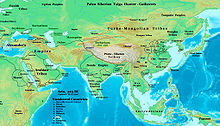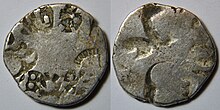Nanda Empire
|
Nanda Empire
|
|||||||||||
|---|---|---|---|---|---|---|---|---|---|---|---|
| 345 BCE–321 BCE | |||||||||||

The Nanda dynasty at its greatest extent under Dhana Nanda c. 325 BCE.
|
|||||||||||
| Capital | Pataliputra | ||||||||||
| Common languages | Old Indic Languages(e.g. Magadhi Prakrit, Other Prakrits) Sanskrit |
||||||||||
| Religion
|
HinduismBrahmanismĀjīvika[1]) Buddhism Jainism[2] |
||||||||||
| Government | Monarchy | ||||||||||
|
• 345-329 BCE
|
Mahapadma Nanda | ||||||||||
|
• 329-321 BCE
|
Dhana Nanda | ||||||||||
| Historical era | Iron Age India | ||||||||||
|
• Established
|
345 BCE | ||||||||||
|
• Disestablished
|
321 BCE | ||||||||||
|
|||||||||||
| Today part of | Bangladesh India Nepal |
||||||||||
|
Part of a series on the
|
|---|
| History of India |
| Outline of South Asian history |
|---|
The Nanda dynasty was an ancient Indian dynasty that originated in Magadha region during the 4th century BCE and lasted between 345–321 BCE. At its greatest extent, the empire ruled by the Nanda Dynasty extended from Bengal in the east, to the Punjab region in the west and as far south as the Vindhya Range.[3] The rulers of this dynasty were famed for the great wealth which they had accumulated. According to the Greek sources, the Nanda army was five times larger than the Macedonian army.[4]The Nanda Empire was finally conquered by Chandragupta Maurya, founder of the Mauryan Empire.
Contents
Establishment of the dynasty
According to Puranas, the founder of the Nanda dynasty was Mahapadma Nanda, whereas Buddhist traditions name him as Ugrasena.[5] Mahapadma, a Shudra, who has been described in the Puranas as "the destroyer of all the Kshatriyas",[6] defeated many other kingdoms, including the Panchalas, Kasis, Haihayas, Kalingas,[a] Asmakas, Kurus, Maithilas, Surasenas and the Vitihotras.[9] He expanded his territory south of the Vindhya Range into the Deccan Plateau. The Nandas, who usurped the throne of the Shishunaga dynasty c. 345 BCE,[10] were thought to be of lowly origin.[11] Mahapadma Nanda was said in the Puranas to be the son of Mahanandin and a Shudramother.[12][13]
Military
The Nanda kings built on the foundations laid by their Haryanka and Shishunaga predecessors to create the first great empire of north India.[2] To achieve this objective they built a vast army, consisting of 200,000 infantry, 20,000 cavalry, 2,000 war chariots and 3,000 war elephants (at the lowest estimates).[14][15][16] According to the Greekhistorian Plutarch, the size of the Nanda army was even larger, numbering 200,000 infantry, 80,000 cavalry, 8,000 war chariots, and 6,000 war elephants.[15][17] However, the Nanda Empire did not have the opportunity to see their army face Alexander, who invaded north-western India at the time of Dhana Nanda, since Alexander was forced to confine his campaign to the plains of Punjab and Sindh, for his forces mutinied at the river Beas and refused to go any further upon encountering "the 4000 well trained and well equipped war elephants" according to Diodorus.[15][18]
A possible indication of Nanda military victories in Kalinga is suggested by the later Hathigumpha inscription of Kharavela, which mentions a King named Nanda building a canal and conquering a place. The existence of a place called Nau Nand Dehra (Nanded) on the Godavari is taken by some scholars as reflecting Nanda rule over the Deccan. The evidence for the extension of Nanda rule into trans-Vindhyan India is not, however, strong.[2]
Wealth
The Nandas were also renowned for their immense wealth. They undertook irrigation projects and invented standardized measures for trade across their empire, and they ruled with the assistance of many ministers.[19] The Nanda Dynasty was also mentioned in the ancient Sangam literature of the Tamil people. The famous Tamil poet Mamulanar described the capital city Pataliputra of the Nanda Dynasty and the wealth and treasure that was accumulated by the great Nanda rulers.[20] Their unpopularity, possibly due to their "financial extortion", facilitated a revolution, leading to their overthrow by Chandragupta Maurya and Chanakya. Nevertheless, "the greatness [...] attained in the Maurya Agewould hardly have been possible but for the achievements of their predecessors", the Nandas.[19]
List of Nanda rulers
The Jaina, Buddhist and Puranic sources all state that the Nanda kings were nine in all. But they differ in the details. The Buddhist Mahabodhivamsa lists the following as the nine Nandas:[2]
- Ugrasena (Mahapadma Nanda)
- Panduka
- Pandugati
- Bhutapala
- Rashtrapala
- Govishanaka
- Dashasiddhaka
- Kaivarta
- Dhana (Agrammes / Xandrames)
The Puranas claim that the first of the nine, Mahapadma, was the father, while the rest were his sons. only one of the sons, Sukalpa, is named. The Buddhist tradition claims that the later eight were brothers.[2]
Courtiers
Jain and Hindu writers refer to a distinguished line of imperial chancellors or advisors of the king from Kalpaka to Sakatala and Rakshasa.[2] The advisors of the king were fewer in number but were more respected on account of their high character and wisdom. They are mentioned by the Greek observers who wrote about conditions in fourth century BCE northern India. Next to the advisors were the 'generals of the army'; one such, Bhadrasala, is mentioned in the Milinda-Panho.[21]
The positions were hereditary in Nanda rule. After Sakatala, the minister of ninth Nanda king, died, his son Sthulabhadra did not take up his position. So Shriyaka, his other son, became the minister.[2]
In literature
A passage of the Kathasaritsagara refers to the kataka (camp) of Nanda in Ayodhya.[9] According to the Visarasreni of Merutunga, the Nandas rose to power in 467 BCE.
'고대 문명 > 고대 인도' 카테고리의 다른 글
| <펌> 인도중왕국 - 위키백과 (0) | 2019.05.24 |
|---|---|
| <펌> 십육대국 (BC 600) - 인도 - 위키백과 (0) | 2019.05.24 |
| <펌> Indus River (0) | 2019.02.04 |
| <펌>Maurya Empire (0) | 2019.02.02 |
| <펌> 우리나라 토속사투리가 산스크리스트어 (0) | 2013.11.08 |


